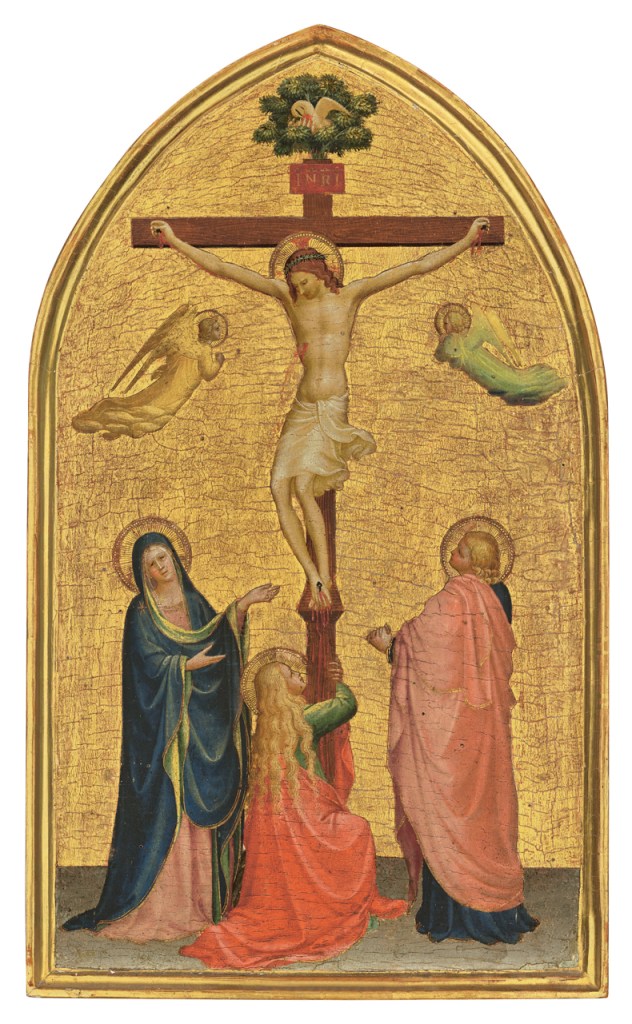Ashmolean Museum
The Crucifixion with the Virgin, Saint John the Evangelist and the Magdalen (early 1420s), Fra Angelico
‘Great works of art have an inevitability of their own,’ wrote Francis Russell, then head of the Old Masters department at Christie’s, nearly 30 years ago in the Burlington Magazine. The occasion was his publication of a hitherto unknown devotional panel of the Crucifixion in an English private collection with an emphatic new attribution to the Florentine friar artist, Fra or Beato Angelico (active 1417–55). ‘It seems astonishing,’ Russell continued, ‘that Fra Angelico’s name has not previously been invoked in connection with [this panel].’ His essay more than remedied the oversight; since then the picture’s status as one of the artist’s defining early works has never been questioned.
There was nothing inevitable, however, about how the Ashmolean Museum in Oxford secured the work for the public at the close of last year. Thought to have been in England from the early 19th century, the painting finally surfaced at Christie’s on 6 July 2023, selling for over £5 million to an overseas buyer. Acting on expert advice, the government issued a temporary export bar and invited domestic buyers to match the sale price. The window of opportunity was, however, forbiddingly narrow: the painting’s export would be deferred for only nine months.
Xa Sturgis and Jennifer Sliwka – Director of the Ashmolean and Keeper of the Museum’s Western Art Department respectively – deserve enormous credit for galvanising a fundraising campaign that just reached its formidable target in time. In November 2024 the museum unveiled its coup, having purchased the painting for £4.5 million by private agreement. Raising such a sum for an Italian gold ground is a truly exceptional achievement.
At the time of writing, the Crucifixion is not in Oxford but in Florence, taking its place in a blockbuster exhibition dedicated to Fra Angelico split between San Marco and the Palazzo Strozzi. The Ashmolean’s generous loan, mere months after the acquisition, allows the painting to be critically considered alongside the artist’s other early works, as well as those by his contemporaries whose influence can be detected in the Oxford panel.
Seeing the Crucifixion in Florence alongside so many comparable examples of the same period underlines both its quality and significance. Here we sense Fra Angelico moving between his training with Lorenzo Monaco and the ferment of innovation that had fully enveloped the visual arts in Florence by the mid 1420s. The Pelican-in-her-Piety at the summit of the cross gestures back to Monaco and older traditions of Crucifixion imagery, but elsewhere in the painting Angelico shows his awareness of Lorenzo Ghiberti, Masaccio and – perhaps most strongly – Gentile da Fabriano. This seems to be Fra Angelico’s earliest surviving depiction of the Crucifixion, a subject he was to paint repeatedly during his career. It is surely earlier than his frescoed Crucifix at San Domenico, Fiesole (recently restored), where Christ’s dipped head reflects Masaccio’s Crucifixion from the Pisa polyptych of 1426.
Writing in the exhibition catalogue, Angelo Tartuferi argues against Laurence Kanter’s earlier proposal that the Ashmolean Crucifixion formed a triptych with two much-altered panels each depicting a pair of saints in a private collection (which are also displayed in Florence, allowing visitors to make their own comparisons). Pending future technical analysis, it seems most likely that Angelico painted the panel as we see it now, an isolated image to absorb the viewer’s devotions.
The picture will remain in excellent company once it is back in Oxford, alongside works by Paolo Uccello and Bicci di Lorenzo. On its return, the Crucifixion will be the centrepiece of Sliwka’s rehang of the Ashmolean’s Renaissance paintings, substantiating Oxford’s ambition to be a ‘world-leading centre for the study of Italian Renaissance art’. Sliwka’s time at the Ashmolean has been relatively brief – she arrived in 2023 and is now moving to Vienna as Director of the Picture Gallery at the Kunsthistorisches Museum – but she leaves an impressive legacy behind in Oxford.

Donal Cooper, professor of Italian and Mediterranean art at the University of Cambridge.

